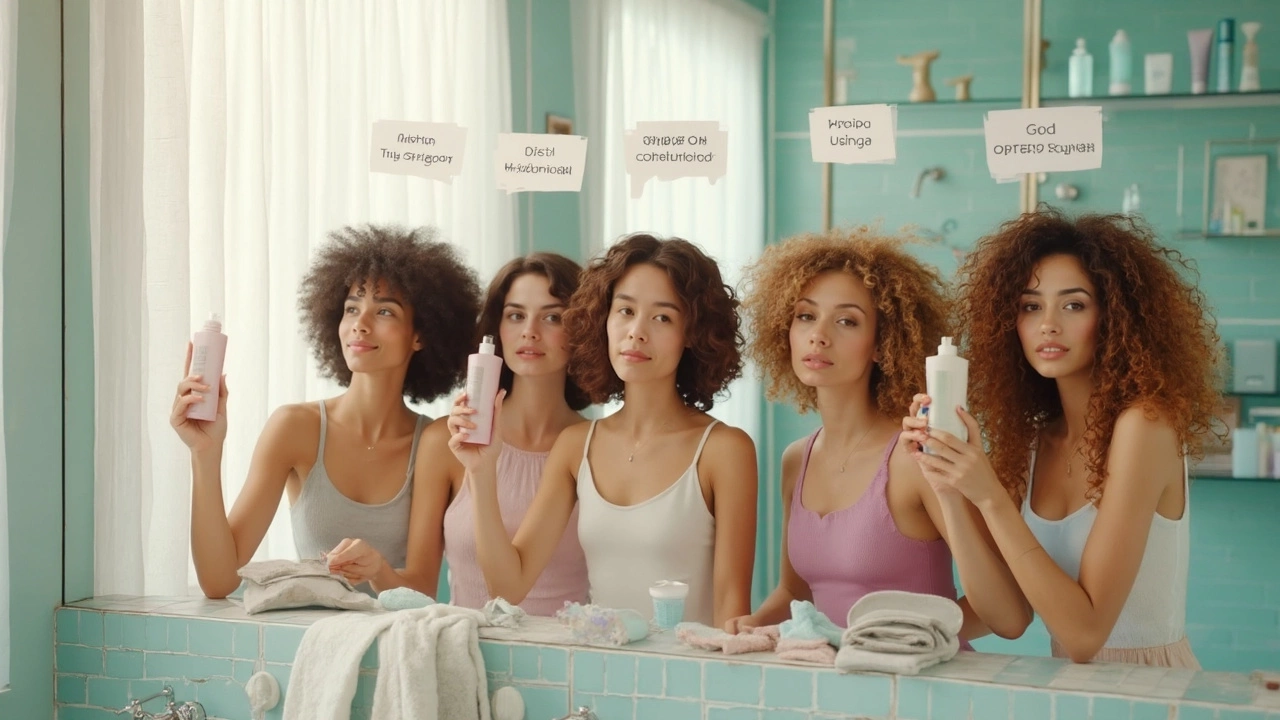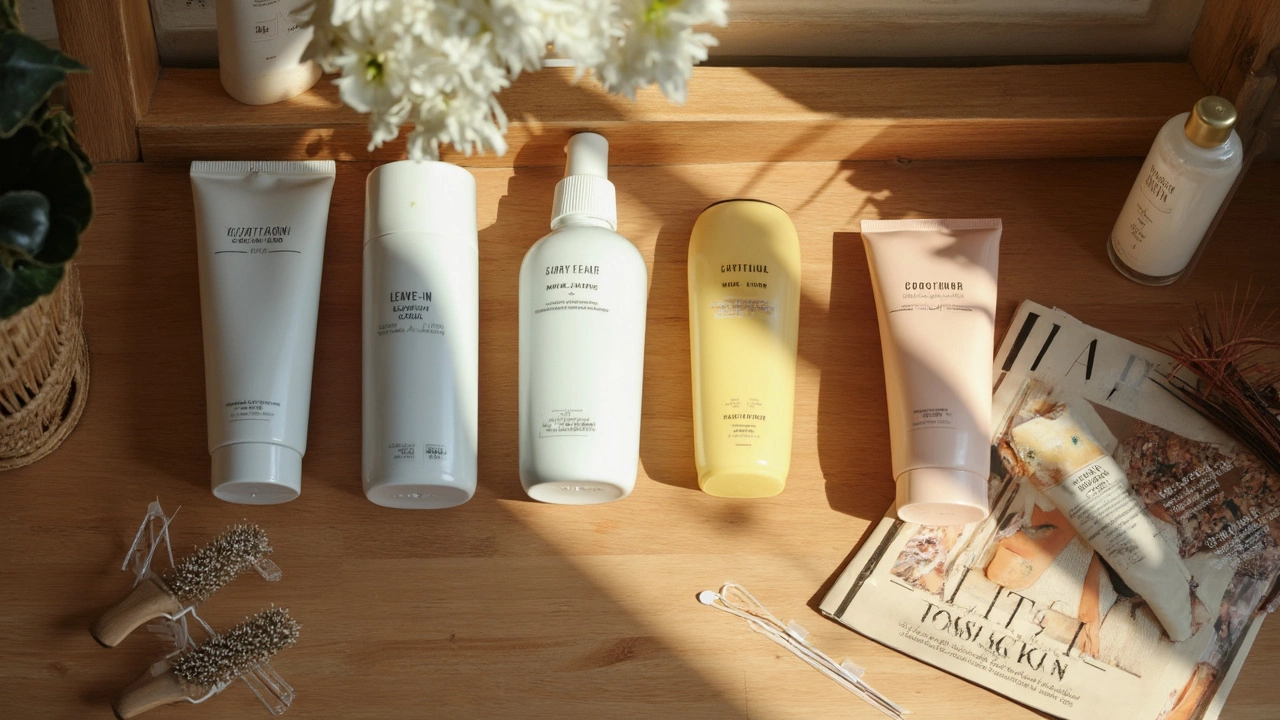Hair Care Routine Order: What Goes Where and Why It Matters
 May, 4 2025
May, 4 2025
Ever wonder if using conditioner before shampoo is a mistake? Or if you’re supposed to put hair oil on wet or dry strands? The order of your hair care routine actually changes how well your products work. If you mix things up, even the most expensive shampoo or mask can end up being a waste.
Here’s the thing: every product is designed for a certain step. Shampoo lifts away dirt and buildup. Conditioner smooths everything back down and adds moisture. Treatments go deeper, so if you use them after piling on heavy products, they can’t get where you need them. And when you layer styling products, the lighter ones go on first, heavier creams or oils last. Get the order wrong, and you risk flat, greasy, or tangly hair—and who’s got time to fix that in the morning?
Let’s sort this out, step by step, and figure out the best routine for whatever your hair is throwing at you. No more guessing. No more product confusion—just a plan that actually works for you.
- Why Order Matters in Hair Care
- Step-by-Step Hair Care Routine
- Customizing for Hair Types and Issues
- Extra Tips for Better Results
Why Order Matters in Hair Care
Ever hear someone say, “Don’t put the cart before the horse?” It’s the same thing with your hair care routine. Doing things in the wrong order can mess with how clean, soft, or even how healthy your hair feels. Here’s why it pays off to be picky about order.
First, think about shampoo. Its whole job is to get rid of oil, dirt, and leftover styling stuff. If you slap on conditioner or a hair mask before shampoo, those products aren’t really touching your hair or scalp—they’re just going to be rinsed away. Shampoo opens up your hair cuticle and scalp, giving you a fresh base for whatever comes next.
On the flip side, conditioner smooths your cuticles right back down. If you use it before shampoo, you’re losing out on its main perks—shine, softness, and way less frizz. Plus, you’ll have a harder time detangling.
When it comes to styling products, order is a big deal, too. If you use a heavy oil first and try to put a lightweight mousse or heat protectant after, you’re basically wasting those lighter products—they won’t get absorbed. Always layer from thin to thick. This way, each product does its job, and you’re not just making your hair feel heavy and greasy by noon.
There’s even research backing this up. A brand study in 2022 showed that 8 out of 10 people who switched to the correct order of shampoo, conditioner, then leave-in products said their hair felt smoother and easier to style. It’s not just about feeling nice—order can actually help the stuff you spend your money on work better.
| Common Routine Mistakes | What Happens |
|---|---|
| Conditioner before shampoo | Hair feels weighed down, less clean |
| Skipping styling product order | Products don’t absorb right, hair greasy or sticky |
| Using hair masks after heavy oils | Mask can’t penetrate, results disappear |
So if you want your hair care routine to actually pay off, trust the process. There’s a reason that bottle says "step one," "step two"—even if it looks like simple marketing. The right order really does make a difference.
Step-by-Step Hair Care Routine
Getting your hair care routine in the right order isn't rocket science, but it does mean fewer bad hair days. Here’s a basic order that works for most people, no matter what products or brands you use.
- Shampoo: Always start with shampoo. It removes sweat, oil, and buildup so other products can actually do their thing. Use warm (not hot) water so you don’t dry your scalp. Most people can get by with one wash, but if your hair is super oily or you use a lot of styling products, a second shampoo can help. Remember, shampoo is meant for your scalp, not your ends.
- Rinse-Out Conditioner: Next, smooth on conditioner—mainly from mid-length to ends. Your roots usually don’t need the extra moisture and can get greasy if you go too close to the scalp. Leave it in for about 2-5 minutes to let it actually do something, then rinse with cooler water to seal in moisture.
- Treatments and Hair Masks: These go after rinsing out conditioner if your hair is really dry or damaged. Treatments like masks or bond-repair formulas need a clear shot at your hair strands, so don’t slap them on after styling products. Most should sit for 5-10 minutes (check the instructions on your product), but don’t overdo it—once a week is plenty for most people.
- Leave-In Conditioner or Detangler: Now that you’re out of the shower, squeeze your hair in a microfiber towel or an old t-shirt (skip regular towels—they cause frizz). Apply leave-in conditioners or detanglers on damp hair, before any styling products. These products help untangle knots and give extra moisture before styling.
- Styling Products: If you use mousse, heat protectant, or volumizer, start here—on damp hair, before any heavy creams or oils. Heavier stylers, like cream or oil, come last, because they seal everything in. Not sure about the order? Go from thinnest to thickest. For example: heat protectant, then mousse, then cream or oil.
Here’s a quick look at how long people typically spend on each step:
| Step | Average Time (minutes) |
|---|---|
| Shampoo | 2 |
| Conditioner | 3 |
| Treatment/Mask | 8 |
| Leave-in/Detangler | 1 |
| Styling Products | 3 |
By sticking to this order, your hair care routine actually delivers what it promises—clean hair, less frizz, easy styling, and a scalp that feels good. Adjust timing or products when you need, but don’t play jumble with the order if you want results.

Customizing for Hair Types and Issues
Your hair care routine shouldn’t be one-size-fits-all. Fine hair, thick hair, curly hair, oily scalps—each needs a different approach. Mess up your routine for your hair type, and you're probably not seeing the results you want.
If your hair is fine or gets oily fast, keep things light. Conditioner goes only on your ends—never at the roots. Anything too rich weighs it down and makes it look greasy. You can even try double shampooing (using a clarifying formula once a week) to stop buildup before it starts.
For thick, coarse, or curly hair, moisture is everything. Flip the script and consider co-washing (using only conditioner) every other wash, and always use leave-in products to fight frizz. Detangle while your hair is soaking wet, ideally with a wide-tooth comb and lots of slip from conditioner. Heavy creams and oils can go from mid-length to ends—these help seal in that elusive moisture.
Dealing with a dry or flaky scalp? Go easy on harsh shampoos. Look for moisturizing or gentle formulas, and don’t skip scalp treatments. Scrubbing your scalp with a soft brush before washing can boost results by clearing away dead skin—just don’t scratch or scrub hard.
If your hair is color-treated, skip sulfate shampoos—they strip color fast. Use products made for dyed hair, and lower the water temp when washing. Cold water helps seal the cuticle, which keeps your vibrant color in longer.
- Fine/oily hair: Light shampoo, minimal conditioner, focus on roots for washing, ends for conditioning.
- Thick/curly hair: Moisturizing shampoo, lots of conditioner, leave-ins, oils, and creams as needed.
- Dry/flaky scalp: Gentle cleansers, scalp treatments, soft brush or massager before wash.
- Color-treated: Sulfate-free shampoo, color-safe products, wash less often.
Check out this quick cheat sheet showing the best routine for each hair type:
| Hair Type | Shampoo | Conditioner | Styling |
|---|---|---|---|
| Fine/Oily | Light, clarifying | Ends only, light formula | Volumizers, skip oils |
| Thick/Curly | Moisturizing, sulfate-free | Rich, from roots to tips | Creams, gels, leave-ins |
| Dry/Flaky Scalp | Gentle, hydrating | Soothing scalp formulas | Serums, scalp oils |
| Color-Treated | Sulfate-free, color-safe | Color-protecting | UV sprays, repair masks |
Don’t be afraid to mix and match as your needs change. Weather, hormones, or even a new workout routine can switch things up, so listen to your hair and tweak your hair care routine when it feels off—or just isn’t working for you.
Extra Tips for Better Results
If you want your hair care routine to really pay off, a few easy tweaks can make a huge difference. Almost everyone has missed some of these before, but sticking to them gives your hair that "just left the salon" feeling—without the price tag.
First up: watch your water temperature. Super hot water feels good but strips away natural oils, leaving hair dry and frizzy. Lukewarm is the sweet spot—for rinsing out shampoo and conditioner both. Cooler water on your final rinse seals the cuticle, making hair shinier.
- If you’re using a hair mask (the step after shampooing and before conditioner), only use it once or twice a week. Overdoing it can weigh hair down—even if it’s a lightweight formula.
- Never pile on styling products at the roots unless they’re meant for root lift. Most creams, serums, and oils should be worked into lengths and ends.
- Detangle with a wide-tooth comb while your hair’s still soaked in conditioner. Brushes can snap wet hair, leading to frizz and breakage.
Lots of people still towel-dry their hair too roughly. Vigorous rubbing roughs up the cuticle and creates more split ends. Instead, blot and gently squeeze with a microfiber towel or even a cotton T-shirt.
Don't forget about product buildup. Using dry shampoo, heavy oils, or silicones all week? Pick a clarifying shampoo once every 1-2 weeks to deep clean without stripping all the good stuff.
For those wondering if order really matters when it comes to results, a recent consumer review on a major beauty site found that 81% of testers noticed smoother, more manageable hair when they started applying products in the correct order.
| Common Mistake | Quick Fix |
|---|---|
| Skipping heat protectant | Always put it on before blow-drying or styling |
| Product buildup | Add a clarifying wash every other week |
| Over-conditioning roots | Focus conditioner on your ends |
Finally, keep an eye on how your hair actually feels each day, not just what the bottle says. Sometimes, less is more. A great hair care routine is all about smart choices, not more steps.
